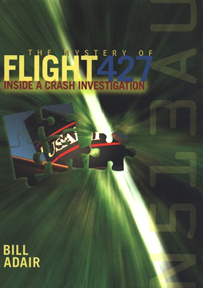 I
have a fear of flying. Oh, I still get on a plane when I need to, but
I grit my teeth (and gulp wine) throughout the flight and breathe a
sigh of relief when the wheels touch down. So why would I read a book
about a fatal plane crash? Maybe it's my wishful way of fending off
catastrophe: If I'm prepared for the worst, it will never happen to
me.
I
have a fear of flying. Oh, I still get on a plane when I need to, but
I grit my teeth (and gulp wine) throughout the flight and breathe a
sigh of relief when the wheels touch down. So why would I read a book
about a fatal plane crash? Maybe it's my wishful way of fending off
catastrophe: If I'm prepared for the worst, it will never happen to
me.
In any case, I
found the crash of USAir Flight 427 outside of Pittsburgh on a perfect,
early evening in September, 1994, particularly compelling. Like a previously
unsolved 1991 United Airlines flight to Colorado Springs, Flight 427
was approaching the airport for landing, when suddenly it rolled in
the air and crashed nose first into a hillside. Twenty-eight seconds
after the first sign of trouble, the Boeing 737 was scattered into hundreds
of thousands of fragments, and all 132 people aboard were dead.
How does the National
Transportation Safety Board (NTSB) go about determining a cause for
such a disaster? The first steps are processes of elimination. For example,
the compactness of Flight 427's debris field made a bomb theory unlikely.
The "black boxes" containing cockpit tape and flight data
ruled out obvious pilot error. A "feather expert" from the
Smithsonian Natural History Museum dismissed a bird strike. (If you
think a bird strike is far-fetched, a four-pound bird hitting a plane
traveling at 300 mph has a fourteen-ton force!) Even a wild theory about
a "fat man" falling through the passenger floor onto a rudder
cable was given brief serious consideration.
Bill Adair was
granted privileged access to the five-year investigation. He's turned
what could have been a depressing overload of technical facts into a
highly readable story from different viewpoints. Foremost is that of
Tom Haueter, crash team leader, whose overriding commitment to solving
the crash threatens his marriage. The victims' ordeal, including mistreatment
by the airline and subsequent lawsuits, is told through a young widower
of the crash, Brett Van Bortel. Adair describes the roles and eccentric
personalities of many of the otherwise nameless engineers who work with
passion and expertise behind the scenes-for example, electrical engineer
Jim Cash, whose self-created database of sounds helps him to solve the
mysterious "bumps" heard on the cockpit tape.
For anyone who doesn't remember, I won't give away the results of the
investigation. Suffice it to say, a cause of the crash was announced,
and airline safety improvements were made based on the findings. Ironically,
this book about a plane disaster may boost my confidence in flying.
I certainly have more faith in the people working to keeping planes
in the air.
Note: The emphasis
throughout the book on information gathering and database creating made
me curious about the role of librarians in the NTSB. So I called NTSB
headquarters in Washington, DC, and spoke with several people in Human
Resources. Unfortunately (for our profession), the agency does not hire
any librarians in spite of the many publications it generates and the
amount of information it must share between departments, and externally
with the FAA, the airlines, Boeing, the pilots' union, etc. I thought
that perhaps NTSB contracted out their librarian services (as EPA in
Seattle does, for example), but was told "no," the agency
doesn't even have a library!


 I
have a fear of flying. Oh, I still get on a plane when I need to, but
I grit my teeth (and gulp wine) throughout the flight and breathe a
sigh of relief when the wheels touch down. So why would I read a book
about a fatal plane crash? Maybe it's my wishful way of fending off
catastrophe: If I'm prepared for the worst, it will never happen to
me.
I
have a fear of flying. Oh, I still get on a plane when I need to, but
I grit my teeth (and gulp wine) throughout the flight and breathe a
sigh of relief when the wheels touch down. So why would I read a book
about a fatal plane crash? Maybe it's my wishful way of fending off
catastrophe: If I'm prepared for the worst, it will never happen to
me.